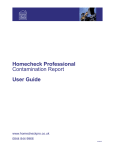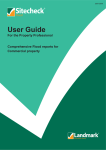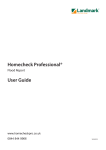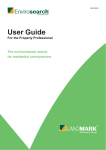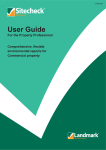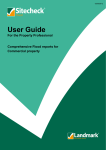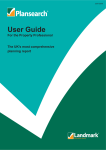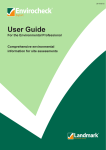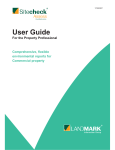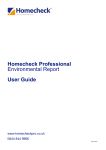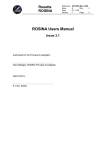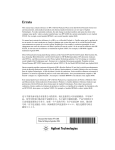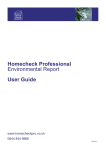Download Homecheck Professional Flood Report User Guide
Transcript
Homecheck Professional Flood Report User Guide www.homecheckpro.co.uk 0844 844 9966 16/08/07 User Guide Table of Contents Introduction - About this Guide 3 Why should I get a Homecheck Professional Flood Report? 3 How do I get a Homecheck Professional Flood Report? 3 What is my Homecheck Professional Flood Report telling me? 4 Appendix Appendix 1: Data sets used in the Homecheck Professional Flood Report 9 2 1. Introduction – About this Guide 1.1 This Guide has been prepared by Landmark Information Group to assist busy conveyancing practitioners to decide: Whether to obtain a Homecheck Professional Flood Report on behalf of their clients. What that search reveals. 2. Why should I get a Homecheck Professional Flood Report? 2.1 According to the Environment Agency, around 5 million people, in 2 million properties, live in flood risk areas in England and Wales. As an "authorised" element of the future Home Information Pack, the Homecheck Professional Flood Report gives the practitioner and their client the vital information they need to decide whether a property is at risk. 3. How do I get a Homecheck Professional Flood Report? 3.1 A Homecheck Professional Flood Report can be ordered by using one of our order forms or alternatively via our website at www.homecheckpro.co.uk. To obtain an order form or register for an account to order online please contact: Landmark Information Group Limited Legal & Financial The Smith Centre Fairmile Henley-on-Thames RG9 6AB Telephone: Fax: DX: E-mail: Internet: 0844 844 9966 0844 844 9980 154400 Henley-on-Thames 2 [email protected] www.homecheckpro.co.uk 3.2 A separate search should be made for each individual property having a different postal address. 3.3 Order forms should be completed by including: The full postal address and postcode of the property. The name and Document Exchange (DX) number (if applicable) of the practitioner. The practitioner’s file reference and telephone number. A plan of the property (see paragraph 3.4 below). 3 3.4 If you are using an order form it is requested that a plan showing the location of the property is enclosed with your order. If a plan is not supplied there may be difficulties in identifying the location of the property and this may introduce a delay. 3.5 In normal circumstances a Homecheck Professional Flood Report will be despatched to the practitioner within 24 to 48 hours of the receipt of the order. 3.6 The Homecheck Professional Flood Report is also available electronically, normally within 24 hours. 4. What is my Homecheck Professional Flood Report telling me? 4.1 The report will include information from a number of statutory and non-statutory sources, and also provides guidance on the presence of features that could create a flood risk. 4.2 Sitescope has agreements for the supply or collection of data with a number of national data providers. Notably, Sitescope is a Licensed Partner of Ordnance Survey and a Value Added Reseller for the Environment Agency and the British Geological Survey. The currency of the datasets used is determined by the frequency of updates by the data providers under their respective agreements with Sitescope. 4.3 Any person relying on a Homecheck Professional Flood Report must comply with the attached Terms and Conditions. 4.4 The replies in the Homecheck Professional Flood Report will be given in the belief that they accord with the data sets and update cycles listed in Appendix 1, but on the understanding that Sitescope is not legally responsible for them except as detailed in the Terms and Conditions, which may vary from time to time. 4.5 Sitescope is constantly working with data providers to improve the data sets and the information available to Sitescope may change. Accordingly, there is no protection period relating to a Homecheck Professional Flood Report and practitioners should not attempt to rely on a previous report. Practitioners who rely on a previous report will not have the benefit of Sitescope’s Professional Indemnity Insurance cover. 4.6 Practitioners should note that addresses may have been compared to the Royal Mail Postal Address File standard and therefore may have been changed to comply with this standard. 4.7 The report is split into sections, which presents the information in an easy to understand question and answer format. 4.8 The practitioner should normally be able to easily verify that the report has been correctly located on the subject property using the Site Location map. In the event of any doubt as to the correct location the practitioner should raise this immediately with our helpdesk or the agent or reseller. 4.9 The Homecheck Professional Flood Report uses the boundary of the property as the basis of the search if this is digitised. Alternatively, the search can be ordered as a point location and our system will construct a 25m radius circle around this point which will be used as the property boundary for the purposes of the report. Please note that use of the 25m circle is not an attempt to make an approximation of the property boundary. 4 Enquiries and Replies 4.10 The Homecheck Professional Flood Report will be based on the information listed in Appendix 1 to this Guide. The practitioners’ attention is drawn to the update cycles for this information. 4.11 Section A of the report will include information from the Environment Agency as to whether the property is: In or within 250 metres of an area affected by flooding (Zone 3) or extreme flooding (Zone 2). In or within 250 metres of flood defences recorded by the Environment Agency. In or within 250 metres of an area recorded by the Environment Agency as benefitting from flood defences. Where data is reported this will be plotted onto a map for easy reference. Please refer to Appendix 1 to this guide and to the footnotes to section A in the report itself for detailed information on the data used in this section. 4.12 Section B of the report will include information from the British Geological Survey (BGS) as to whether the property is within an area susceptible to groundwater flooding or whether there are geological deposits that indicate the area may be vulnerable to inland or coastal flooding. The search area for this section is 0 - 50 metres from the specified property. Suseptibility to groundwater flooding will report the worst case within the search area and the responses are: None Negligible Low Moderate Moderately High High Where susceptibility is negligible, this means that you need take no further action in relation to groundwater hazard in this area. Where low or moderate susceptibility is indicated, this means that given the geological conditions there may be a groundwater flooding hazard. Unless other relevant information, e.g. records of previous flooding, suggests groundwater flooding has occurred before in this area you need take no further action in relation to groundwater flooding hazard. If there are records of previous incidences of groundwater flooding, then it is recommended that other information e.g. rainfall history, property type, and land drainage information in addition to previous records of flooding be investigated in order to establish relative, but not absolute, risk of groundwater flooding. 5 Where moderately high or high susceptibility is indicated, this means that given the geological conditions in the area groundwater flooding hazard should be considered in all land-use planning decisions. It is recommended that other relevant information e.g. records of previous incidence of groundwater flooding, rainfall, property type, and land drainage information be investigated in order to establish relative, but not absolute, risk of groundwater flooding. Geological Indicators of Flooding simply gives a yes or no reply. Please refer to Appendix 1 to this guide and to the footnotes to section B in the report itself for detailed information on the data used in this section. 4.13 Section C of the report will include information from Norwich Union (NU) as to their assessment of the flood risk to the property and the insurability risk assessment of the property. The flood risk responses are: High Medium Low Negligible May Become Isolated No Data Availble Where the flood risk is "High" based on Norwich Union’s assessment of flood risk, the property has a flood risk more frequent than a 1 in 75 year flood event. Where the flood risk is "Medium" based on Norwich Union’s assessment of flood risk, the property has a flood risk between a 1 in 75 year, and 1 in 250 year flood event. Where the flood risk is "Low" based on Norwich Union’s assessment of flood risk , the property has a flood risk between a 1 in 250 year, and 1 in 1000 year flood event. Where the flood risk is "Negligible" based on Norwich Union’s assessment of flood risk, the property has a negligible flood risk. Where the flood risk is "May become isolated" based on Norwich Union’s assessment of flood risk , the property may become isolated or surrounded by flood waters in the event of a 1 in 250 year flood event. The property itself is unlikely to flood. The insurability risk assessment responses are: Significant High Moderate Low Very Low Negligible May Become Isolated No Data Available 6 Where the insurability risk assessment is "Significant" the insurer’s assessment of flood risk at this property indicates that there is a significant risk of flooding, and without evidence of appropriate flood defences it would not be prepared to insure this property. You may be required to purchase a Flood Risk Assessment survey in order to provide this evidence. Insurer recommends you consider flood protection measures. Where the insurability risk assessment is "High" the insurer’s assessment of flood risk at this property indicates that the property is built on a flood plain and there is a high probability of flooding. Insurer would be prepared to offer cover for flooding if it were to insure this property. Properties with a high probability of flooding may attract higher insurance premiums and/or claims excesses. You may wish to consider looking for suppliers of flood prevention products. Where the insurability risk assessment is "Moderate" the insurer’s assessment of flood risk at this property indicates that the property is built on a flood plain and there is a moderate probability of flooding. Insurer would be prepared to offer cover for flooding if it were to insure this property. Properties with a moderate probability of flooding may attract higher insurance premiums. Where the insurability risk assessment is "Low" the insurer’s assessment of flood risk at this property indicates that the property is built on a flood plain and there is a low probability of flooding. Insurer would be prepared to offer cover for flooding if it were to insure this property. Properties with a low probability of flooding may attract a small increase in insurance premiums to cover the risk. Where the insurability risk assessment is "Very low" the insurer’s assessment of flood risk at this property indicates that whilst the property is built on a flood plain there is a very low probability of flooding. Insurer would be prepared to offer cover for flooding if it were to insure this property. Where the insurability risk assessment is "Negligible" the insurer’s assessment of flood risk at this property indicates that there is a negligible risk of flooding. Where the insurability risk assessment is "May become isolated" the insurer’s assessment of flood risk at this property indicates that in an extreme flood event this property may become isolated or surrounded by flood waters. This property itself is unlikely to flood. Please note that these assessments of the insurability of the property are from Norwich Union. If the response raises concerns you should check with your own insurance company. Where the report advises “No Data Available” for section C this means the location of your property is not yet included in the Ordnance Survey’s Address-Point data. This could occur if your property is newly built or is a plot in a new development. In such cases Landmark can obtain information from Norwich Union on a case by case basis, normally within 2 working days. Should you require Landmark to obtain this information please contact our Customer Service team on 0844 844 9966. Please refer to Appendix 1 to this guide and to the footnotes to section C in the report itself for detailed information on the data used in this section. 7 4.14 Section D of the report will include information from Crawford & Co. as to their assessment of the flood insurance claim rating for the property's postcode sector. Crawford & Co. are the world’s largest independent provider of claims management solutions to insurance companies, and self-insured entities, with a global network of more than 700 offices in 63 countries. With over 60 years in the business, Crawford offers claims management solutions across a number of areas which include property and casualty, healthcare and rehabilitation, counter fraud services, major loss and incident management and surveying. Crawford & Co have generated an insurance claims rating for flood risk which is determined by comparing the number of flooding insurance claims made to the total number of properties in the postcode sector. The data includes validated claims notified to insurers including river and coastal flood, heavy rainfall and flooding following blockages to sewers etc. They do not include an escape of water from a fixed appliance. The insurance claim rating responses are: High Medium Low Very Low No Data Available "High" is usually (but not invariably) associated with river or coastal flood. It is usually indicative of groups of claims with several properties suffering damage as the result of a specific event. Frequency varies by sector but this would indicate an average of around 35 claims with a large variation both between sectors and within individual sectors. "Medium" is usually indicative of groups of houses, not necessarily over a wide area, that have suffered damage as a result of heavy rainfall, over-topping of the rainwater system or their location being on low lying ground. The average in this range is around 9 claims. "Low" suggests individual claims associated with failure of underground drainage systems or possibly localised events like flooding of the roadway following heavy rainfall. Claim numbers in these sectors would be low with an average less than 5 claims. "Very Low" indicates there are no recorded claims. "No Data Available" means there are insufficient properties in the postcode sector to make a meaningful assessment. 4.15 It should be noted that the data in each section is supplied from different sources and is based on different parameters. This may give rise to what might at first seem to be conflicting responses. For example, data in section C is specific to the subject property whereas the data in section D ` relates to the postcode sector. A report could therefore be assessed as “High” in section C for both Flood and Insurability Risk and have a “Low” Insurance Claim Rating. 8 Appendix 1: Data Sets Used in the Homecheck Professional Flood Report Title Remarks Areas Benefiting This data set shows those areas benefiting from from Flood Defences demarcated flood defences whereby in a 1% fluvial or 0.5% tidal flood event, areas that would otherwise flood are protected provided that the defences do not breach. Source Data Type Data Range Update Cycle Section Environment Agency Polygon & Text From 2005 Quarterly A BGS Groundwater Flooding Susceptibility This data set is the first national hazard or susceptibility British Geological data set of groundwater flooding. The first release of Survey (BGS) the data set (April 2007) covers England & Wales, but will be extended to Scotland at a later date. Groundwater flooding is increasingly recognised as a hazard and can be defined as the emergence of groundwater at the ground surface, or the rising of groundwater into man-made ground under conditions where the normal range of groundwater levels is exceeded. Based on geological and hydrogeological information, digital data has been used to identify areas where geological conditions could enable groundwater flooding to occur and where groundwater may come close to the ground surface. The data set defines areas with one of five levels of groundwater susceptibility, ranging from high susceptibility to negligible or no susceptibility. Areas with no data represent areas with no susceptibility to groundwater flooding. The resolution of the modelled output is 50m by 50m cells. The data set is a hazard data set, not a risk data set, meaning that it does not provide any information about the likelihood of a groundwater flooding event occurring. Polygon & Text Not Applicable Annual B BGS Geological Indicators of Flooding This data set identifies areas prone to the two main British Geological Survey (BGS) types of flooding - inland (fluvial floodplains) and coastal/estuarine, based upon the observation of the types of geological deposit present. The first release of the data set (April 2007) covers England & Wales, but will be extended to Scotland at a later date. The data set is a digital map based on the BGS Digital Geological Map of Great Britain at the 1:50,000 scale. It was produced by characterising Superficial (Drift) Deposits on this map in terms of their likely vulnerability to flooding, either from coastal or inland water flow. These Superficial Deposits are considered ‘recent’ in geological terms, most having been formed in the later parts of the Quaternary geological period (i.e. within the last few tens of thousands of years). Observations made during recent major inland and coastal flooding events have demonstrated that the erosion and deposition of these recent geological sediments have produced subtle topographical variations, resulting in landforms such as fluvial and coastal floodplains. The mapping of these landforms, in conjunction with the fluvial and/or coastal deposits that underlie them, has in turn determined the extent of previous coastal and inland flooding. The data set does not take into account any manmade influences such as flood protection schemes, nor does it take into account the possibility of flooding onto low-lying ground that is not occupied by the ‘indicator’ deposits described above. Polygon & Text Not Applicable Annual B Polygon & Text From 2005 Quarterly A Extreme Flooding from Rivers or Sea without Defences (Zone 2) Flood Zones are defined by the Government’s Planning Policy Guidance 25 on ‘Development and flood Risk’ for England (PPG25) dated July 2001. The Flood Zones illustrate the probability of flooding across England for planning consultation. The Flood Zones have been identified using the best available data held by the Environment Agency ignoring the presence of flood defences (as required by PPG25, reference table 1 note (a)). This data set is Flood Zone 2, the Environment Agency’s best estimate of the areas of land, ignoring the presence of defences with an annual probability of flooding of 0.1 % (1 in 1000) or greater from rivers and the sea, but with an annual probability of flooding of less than 1.0 % from rivers. This definition of Flood Zone 2 applies only in England. Equivalent data is also provided for Wales, although in Wales the data on this layer of the Flood Map does not have the same relationship to Planning Guidance and is not referred to as Flood Zones. Environment Agency 9 Appendix 1: Data Sets Used in the Homecheck Professional Flood Report Title Remarks Source Data Type Data Range Update Cycle Section Flood Defences This is the Environment Agency’s holding of Linear Flood Defences. This data set contains all flood defences constructed during the last five years with a standard of protection equal to or better than 1% for rivers and 0.5% from the sea. Some additional defences, which may be older or may have been designed to provide a lower standard of protection, are also shown where the information is currently available. This layer comprises linear flood defences, for example flood embankments and walls. Environment Agency Polygon & Text From 2005 Quarterly A Flooding from Rivers or Sea without Defences (Zone 3) Flood Zones are defined by the Government’s Planning Policy Guidance 25 on ‘Development and Flood Risk’ for England (PPG25) dated July 2001. The Flood Zones illustrate the probability of flooding across England for planning consultation. The Flood Zones have been identified using the best available data held by the Environment Agency ignoring the presence of flood defences (as required by PPG25, reference table 1 note (a)). This data set is Flood Zone 3, the Environment Agency’s best estimate of the areas of land, ignoring the presence of defences with an annual probability of flooding of 1.0 % (1 in 100) or greater from rivers, and 0.5 % (1 in 200) or greater from the sea. This definition of Flood Zone 3 applies only in England. Equivalent data is also provided for Wales, although in Wales the data on this layer of the Flood Map does not have the same relationship to Planning Guidance and is not referred to as Flood Zones. Environment Agency Polygon & Text From 2005 Quarterly A Flood Water Storage Areas The Environment Agency’s holding of ‘Flood Storage Areas’. A flood storage area may be referred to as a balancing reservoir, storage basin or balancing pond. Its purpose is to attenuate an incoming flood peak to a flow level that can be accepted by the downstream channel. It may also delay the timing of a flood peak so that its volume is discharged over a longer time interval. Environment Agency Polygon & Text From 2005 Quarterly A Postcode Sector Insurance Claim Ratings - Flood This data set contains postcode sector based flood insurance claim ratings. Postcode sectors are supplied as digital polygons, to which insurance claim ratings are applied. The rating system has five levels, and is determined by comparing the number of flood insurance claims made, to the number of properties within the postcode sector. Four levels range from ‘Very Low’ to ‘High’, whilst the fifth category represents postcode sectors that have too few properties contained within them to make an assessment. Crawford & Co Polygon & Text From 2000 Quarterly C Property-based Flood Risk This data set provides a property-based flood risk for all residential properties within the UK as supplied by Norwich Union (NU) insurance company. There are five levels of flood risk: High - Property has a flood risk more frequent than a 1 in 75 year event. Medium - Property has a flood risk between a 1 in 75 year and 1 in 250 year event. Low - Property has a flood risk between a 1 in 250 year and 1 in 1000 year event. Negligible - Property has a negligible risk of flooding, or is not on a flood plain. May Become Isolated - Property itself is not at risk of flooding however it may be isolated by flood waters in a 1 in 250 year event. In addition, each property is assigned one of 7 insurability assessments dependant upon the risk of flooding. For this to happen, the Medium (Amber) flood risk is broken down into more granular levels. NU use Ordnance Survey’s Address-Point data to locate each individual address, before running an algorithm to assign individual properties a flood-risk rating and insurability assessment. Norwich Union Point & Text Not Applicable Annually D 10










